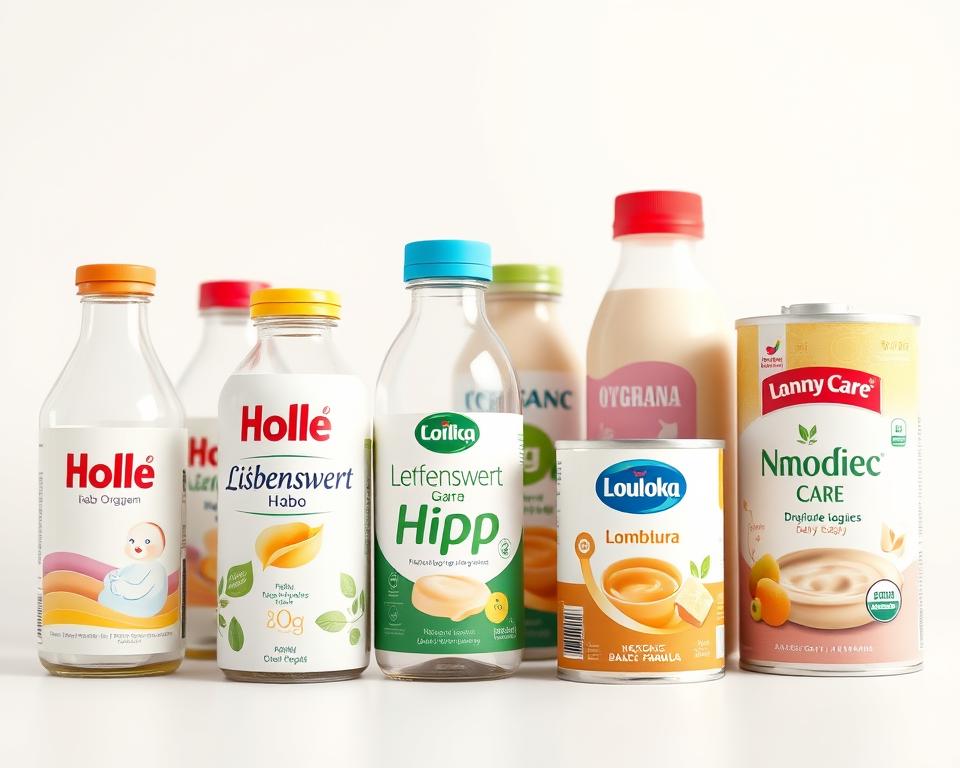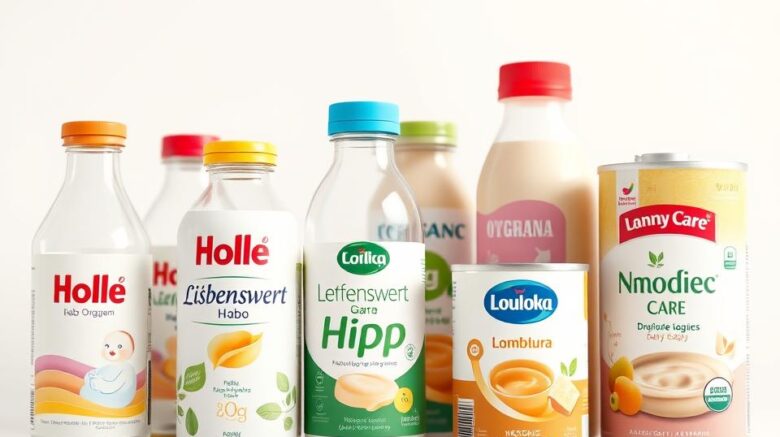Uncover the Best Organic Formula Options: Mom & Dad’s Manual
Almost eight in ten U.S. moms and dads rely on formula during their baby’s first year. This is often due to breastfeeding challenges. Selecting the proper buy organic newborn formula online proves crucial for such households. Our handbook helps caregivers choose the optimum organic formula for their little ones.
Let’s explore different formulas by brand, highlighting quality and health. Such details ensure your baby begins life on a strong nutritional foundation.
Every caregiver faces the weighty choice of baby’s first foods. Organic infant formula has gained popularity due to its focus on organic ingredients. It offers a cleaner feeding alternative. Free from artificial pesticides and fertilizers, they offer infants a purer beginning.
Parents are increasingly mindful of the absence of harmful chemicals like GMOs and artificial additives. These worries underscore why organic formulas are the preferred safe option.
Benefits of Organic Ingredients
Certified organic components deliver notable advantages. These ingredients are rigorously tested, ensuring higher quality and safety. Selecting these formulas ensures infants escape dangerous additives.
The cultivation processes involved in organic farming emphasize sustainability and environmental preservation. Thus, organic choices support both your baby’s health and the planet.
Linked Wellness Benefits
These formulas may foster healthier developmental results. Research shows organic-fed infants tend toward fewer tummy troubles and allergy risks. Purity stems from their additive-free makeup.
Parents find comfort in knowing that organic options provide balanced nutrition. They support both growth and overall wellness for their babies.

Key Features to Look for in Organic Baby Formula
Selecting premier organic infant formula matters dramatically for your child’s wellbeing. Examine both protein origins and vital micronutrients. The type and ratio of proteins can affect how well a baby digests and uses nutrients. Also, knowing the essential nutrients ensures your baby gets the best support for growth and development.
Protein Sources and Ratios
Most baby formulas use whey and casein as protein sources. Whey breaks down quickly and casein releases nutrients gradually. The whey-to-casein ratio is key, with a higher whey ratio being better for a baby’s sensitive stomach. Many organic options boost whey content for digestive comfort. Choose products that specify their protein blend and proper proportions.
Vital Additives and Health Boosters
Critical nutrients make a big difference in formula selection. DHA/ARA essential for cognitive and ocular growth. Prebiotics also play a role in digestive health and immune system strength. Check for these additives in formulas to ensure your baby gets a full range of nutrients. These organics provide robust nutrient profiles.
| Protein Source | Benefits | Whey-to-Casein Ratio |
|---|---|---|
| Whey | Easier digestibility|Gentle on tummies|Quick absorption | Higher ratio is better|Lean whey blend preferred|Above 60% ideal |
| Casein | Slow release of nutrients|Sustained nourishment|Stomach-friendly over time | Lower ratio preferred in early months|Casein kept minimal|Around 40% or less |
Top-Rated Organic Formula Brands
Moms and dads rely on established brands when buying organics. Here are premier brands with their signature benefits. They lead the organic formula market, serving diverse dietary demands.
Kendamil: The Whole Milk Option
Kendamil is unique as the only organic baby formula made with whole milk. It offers a smooth mouthfeel without synthetic extras. It’s a top pick for parents who value purity in their baby’s diet. Ordering Kendamil via the web is easy and rapid.
HiPP Combiotik: The Gentle Choice for Sensitive Tummies
Designed to soothe, Combiotik suits babies with sensitive guts. Combines prebiotic fibers and live cultures to aid gut health. Parents often choose HiPP for its commitment to organic, high-quality ingredients, making it a favorite in organic baby food shops.
Holle Bio: Trusted European Quality
Holle Bio is renowned for its biodynamic farming practices, providing premium certified organic formula. It’s known for its rigorous quality control and commitment to health and the environment. Moms and dads pick Holle for its reliable quality and wholesome makeup.
Aussie Bubs Grass-Fed Blend
By sourcing from grass-fed herds, Aussie Bubs maximizes nutrient density. All components reflect a back-to-nature approach. Its grass-fed pedigree signals high standards to parents.
Bobbie: Modern Nutritional Innovations
Leading-edge and organic, Bobbie sets new standards. It meets contemporary dietary needs while upholding organic integrity. Moms and dads trust Bobbie for its evidence-based, organic formula.
Choosing the right organic formula for your baby requires careful thought about their dietary needs. Recognizing food sensitivities helps you avoid tummy troubles. Component choices matter for infants prone to digestive issues.
Identifying Feeding Intolerances
Infants can respond poorly to lactose or intact proteins. Look for formulas designed for sensitive infants. For instance, organic formulas for sensitive tummies often have less lactose or proteins that are partially hydrolyzed. They work to calm upset stomachs and nurture gut balance.
Talk with your child’s doctor before switching formulas.
Considering Digestive Comfort
Digestive comfort is essential for infants, and the right organic formula is key. These compounds encourage a healthy microbiome and smoother digestion. By fostering beneficial bacteria, they enhance absorption and gut health.
Mothers supplementing with formula can find options mimicking breast milk nutrients.
How to Transition to Organic Baby Formula
You can transition infants from breastfeeding or standard formula to organic smoothly. Grasping best practices eases the process for you and baby. Incremental adjustments support baby’s adaptation to new formula.
Steps for a Smooth Transition
First, add a bit of organic formula to your usual blend. Here are some effective steps for a seamless transition:
- Kick off by blending one part organic with three parts regular formula.
- Each day, shift the ratio more toward organics and away from the old formula.
- Watch for fussiness or digestion changes and adjust pace as needed.
- Serve the new formula during calm periods so baby links it with comfort.
- Maintain regular feeding schedules to aid adaptation.
Signs of Good Acceptance
Spotting these indicators confirms a smooth adaptation:
- Infant feeds calmly with little to no protest.
- Normal poops and easy digestion continue.
- Hunger levels and feeding frequency stay stable.
- Your baby appears happy and content after feedings.
Though gradual, these cues show your baby is thriving on the new formula.
Organic vs. Standard Baby Formulas
Choosing between organic and standard formulas ranks high among parental dilemmas. Making the right pick ensures optimal nutrition for little ones. The focus on ingredient safety and health benefits often guides their choice in this important aspect of parenting.
Ingredient Differences
The main difference between organic and traditional formulas is in their ingredients. Organics rely on farm-fresh ingredients without synthetic extras. Names like HiPP, Kendamil partner with organic producers for premium milk. Conventional blends sometimes contain lab-made vitamins and non-certified ingredients. It underscores why organics champion pure, unprocessed feeding.
Price Differences
Organic formulas generally carry premium pricing because of certification expenses. Certification and sustainable farming drive up the price tag on organics. Caregivers often deem the extra expense justified by wellness gains. Evaluating price and quality ensures a match with financial and health priorities.
Digital retailers have transformed organic formula purchasing. Now, they can purchase top-notch formulas from home. Online options cover everything from hypoallergenic to grass-fed blends.
Online Retail Advantages
E-commerce fits into jam-packed daily routines. Easy ordering from any location.
- Convenience
- Endless formula choices online
- E-tailer discounts often undercut store prices
Subscription Services Explained
Infant formula subscription services have become increasingly popular. Automated orders keep your formula supply constant.
Subscription plans typically offer these perks:
- Never worry about restocking
- Set delivery intervals to match your consumption rate
- Save money with recurring order deals
Regulatory Standards for Organic Baby Formulas
Guaranteeing formula purity demands robust regulation. This is governed by multiple compliance layers. Parents can rest assured knowing that FDA regulations on infant formula ensure safety. USDA organics approval confirms true organic sourcing. Understanding these standards empowers parents to make informed choices for their infants.
FDA Oversight and Standards
The Food and Drug Administration sets essential formula rules. Their strict guidelines cover nutrient requirements and permissible ingredients. These mandates secure infant dietary adequacy. Key aspects include:
- Mandatory ingredient listings|Required ingredient disclosures|Compulsory component labeling
- Specific nutrient requirements such as protein, fats, and vitamins|Defined macro- and micronutrient thresholds|Preset nutrition minimums
- Comprehensive quality control measures during manufacturing|Rigorous production inspections|Stringent safety checks
Compliance ensures safe, well-balanced formula offerings.
USDA Organic Certification Guidelines
USDA organics seals mark trusted formula authenticity. USDA checks confirm full adherence to organic protocols. Major requirements are:
- Proof that ingredients are produced without synthetic fertilizers or pesticides|No chemical fertilizers or sprays used|Farm inputs must be 100% natural
- Verification of non-GMO (genetically modified organism) status|Guarantee of GMO-free sourcing|Strict non-GMO testing
- Clear guidelines on the handling and processing of organic products|Protected organic integrity during production|Certified organic processing rules
USDA label confirms field-to-formula organics. This promotes healthier options for infants. Together, these frameworks give caregivers full assurance.
| Regulatory Aspect | Description |
|---|---|
| FDA Regulations | Sets safety and nutrient standards for infant formula |
| USDA Organic Certification | Ensures organic ingredients are grown without harmful substances |
| Quality Control | Mandatory checks during production processes |
| Ingredient Transparency | Clear labeling of all components for consumer knowledge |
Tips for Buying Organic Baby Formula
Choosing the right organic baby formula can seem daunting. But with key tips, parents can confidently select the best option. Knowing where to shop and what to look for in labels makes the process smoother.
Where to Buy Organic Baby Formula Online
Many trusted online stores offer a broad range of organic baby formulas. These sites frequently run promotions. Consider these popular options:
- Amazon – Known for its wide variety and fast shipping
- Target – Provides flexible shipping and pickup services
- Walmart – Provides both online shopping and local availability
- Thrive Market – Specializes in natural and organic groceries
Review shopper comments for real-world insights. Ratings reveal formula efficacy and seller trustworthiness.
Certification Guide
Knowing label terminology ensures you get true organics. Check for recognized organic marks. Typical certifications are:
| Certification | Description |
|---|---|
| USDA Organic | Indicates the formula contains at least 95% organic ingredients |
| Non-GMO Project Verified | Means the formula does not use genetically modified organisms |
| European Union Organic | Denotes adherence to EU organic farming regulations |
Recognizing seals guarantees purity and health.
In Closing
To wrap up, careful formula selection supports optimal baby development. Organics bring peace of mind beyond mere nutrition. Your baby receives balanced nourishment free from chemicals. Caregivers now know to check protein ratios, sensitivity profiles, and top names like Kendamil and Holle.
This article highlighted the need for formulas that meet your baby’s specific needs. Transitioning to organic options should be a careful process. Incremental change safeguards digestive ease.
Using these insights helps caregivers navigate the crowded formula field. Opting for organic feeding fosters lifelong nutritional good habits. Remain committed to offering the best start in life. Empower early eating habits with carefully selected organics.
